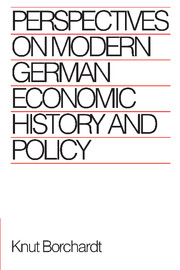Book contents
- Frontmatter
- Contents
- List of figures
- List of tables
- Preface to the English edition
- Preface to the German edition
- List of original chapter titles and first places of publication
- Abbreviations
- 1 Protectionism in historical perspective
- 2 Was there a capital shortage in the first half of the nineteenth century in Germany?
- 3 Regional variations in growth in Germany in the nineteenth century with particular reference to the west—east developmental gradient
- 4 Investment in education and instruction in the nineteenth century
- 5 Changes in the phenomenon of the business cycle over the last hundred years
- 6 Trends, cycles, structural breaks, chance: what determines twentieth-century German economic history?
- 7 The Federal Republic of Germany in the secular trend of economic development
- 8 Germany's experience of inflation
- 9 Constraints and room for manoeuvre in the great depression of the early thirties: towards a revision of the received historical picture
- 10 Economic causes of the collapse of the Weimar Republic
- 11 Germany's exchange rate options during the great depression
- Notes
- Index
1 - Protectionism in historical perspective
Published online by Cambridge University Press: 10 December 2009
- Frontmatter
- Contents
- List of figures
- List of tables
- Preface to the English edition
- Preface to the German edition
- List of original chapter titles and first places of publication
- Abbreviations
- 1 Protectionism in historical perspective
- 2 Was there a capital shortage in the first half of the nineteenth century in Germany?
- 3 Regional variations in growth in Germany in the nineteenth century with particular reference to the west—east developmental gradient
- 4 Investment in education and instruction in the nineteenth century
- 5 Changes in the phenomenon of the business cycle over the last hundred years
- 6 Trends, cycles, structural breaks, chance: what determines twentieth-century German economic history?
- 7 The Federal Republic of Germany in the secular trend of economic development
- 8 Germany's experience of inflation
- 9 Constraints and room for manoeuvre in the great depression of the early thirties: towards a revision of the received historical picture
- 10 Economic causes of the collapse of the Weimar Republic
- 11 Germany's exchange rate options during the great depression
- Notes
- Index
Summary
When in Britain in the 1900s a debate broke out about Joseph Chamberlain's proposals for protective tariffs, one consequence — among other perhaps more important repercussions — was to split an academic economic community which until then had been held together with some difficulty by Alfred Marshall. Now it was possible to discern alongside theoretical economists a group of economic historians. The historians welcomed Chamberlain's view, while the theoreticians who were still deeply committed to classical traditions opposed it.
How should I see my present role in the light of this historical background? There are certainly economic historians who today take the same side as their early predecessors. Among them are not just old-fashioned enemies of theory, but also historical econometricians — so-called cliometricians, who do not simply pronounce value judgements but attempt to test hypotheses with the help of carefully constructed mathematical models.
Despite this I should perhaps join the impressive majority of theorists who since the end of the eighteenth century have again and again opposed the growth of protectionism. In 1930, over a thousand university teachers signed an appeal to the US President not to sign the now infamous Hawley-Smoot tariff law if it were to receive the support of Congress (as seemed likely).
- Type
- Chapter
- Information
- Publisher: Cambridge University PressPrint publication year: 1991



